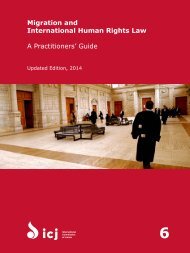Create successful ePaper yourself
Turn your PDF publications into a flip-book with our unique Google optimized e-Paper software.
EASO Country of Origin Information report — South and Central <strong>Somalia</strong> — Country overview — 45<br />
frictions, provided both sides are capable to pay mag ( 288 ). Anthropologists and Somalis alike often disagree about<br />
the exact genealogies of many groups, such as the Isaaq, who are considered an own clan family by some and a Dir<br />
clan by others ( 289 ). Furthermore, minorities and occupational groups (see section 2.2. below) have the possibility to<br />
enter client relationships with noble clans, which are in some cases so stable that the groups are considered to be<br />
a part of the noble clan, with regard to, however, solely external relations ( 290 ). The minority group of the Sheikhal,<br />
for example, even occupies some Hawiye seats in the Somali parliament ( 291 ).<br />
Several clan genealogy charts and maps are available online, the variations and contradictions of which illustrate<br />
the dynamics and complexities described above. The most commonly used are Abbink 2009 ( 292 ), UNHCR <strong>Somalia</strong><br />
2000 ( 293 ), World Bank 2005 ( 294 ) and U.S. Department of State 2000 ( 295 ). For maps, see section 2.4.<br />
When listing their family/clan ancestry, Somalis start with themselves and go upwards to the clan family. This listing<br />
is known as either abtirsiimo or abtirsiin (literally: ‘the counting of fathers’). Both terms are equivalent and used in<br />
the two main versions of Somali language, Maxaa‐tiri and Maay‐tiri. Somalis can give some generations in their clan<br />
line, in some cases up to 25 generations. Children learn their abtirsiimo/abtirsiin primarily from their mother and<br />
grandmother. They start learning as early as the age of five. Usually, a child knows his/her abtiirsimo/abtiirsin by heart<br />
at the age of eight or nine. Abtirsiimo/abtirsiin is used when one discusses patrimony and ancestors, when majority<br />
clans try to dominate minority clans, to praise famous persons in one’s clan and to show that one is related to that<br />
person. Abtirsiimo/abtirsiin is also used to find parents and relatives of unaccompanied children ( 296 ).<br />
2.2 Minority groups<br />
Somali minorities are diverse, with categories such as ethnic and religious minorities and occupational groups. The<br />
ethnic and religious minorities have a different cultural and language background than Somalis from the pastoralist<br />
majority clans, while the occupational groups share their background, but practice specific non‐pastoralist occupations<br />
(see section 2.3) ( 297 ). Furthermore, members of majority clans can be considered minorities where they live in an<br />
area mainly populated by another majority clan. An example of this phenomenon are the Biyomaal, who belong to<br />
the ‘noble’ Dir clan family, who are a minority in the south, where they are suppressed by the Hawiye and Darod ( 298 ).<br />
2.2.1 Ethnic minority groups<br />
Most ethnic minorities are descendants of immigrants from eastern and central Africa or from the Arabian Peninsula.<br />
Some minorities already settled in <strong>Somalia</strong> before the arrival of the Somalis ( 299 ). There are no reliable data about<br />
( 288 ) ACCORD, Clans in <strong>Somalia</strong>. <strong>Report</strong> on a Lecture by Joakim Gundel, December 2009 (http://www.ecoi.net/file_upload/90_1261130976_<br />
accord‐report‐clans‐in‐somalia‐revised‐edition-20091215.pdf) accessed 10 June 2014, p. 9.<br />
( 289 ) Cf.: Abbink, J., ‘The total Somali clan genealogy (second edition)’, ASCO Working Paper 84/2009, 2009 (https://openaccess.leidenuniv.nl/handle/1887/14007)<br />
accessed 10 June 2014, p. 1-2.<br />
( 290 ) Tiwald, A., Die Parias <strong>Somalia</strong>s: Ständische Berufskasten als Basis sozialer Diskriminierung, Österreichischer Integrationsfonds, December 2010 (http://www.<br />
integrationsfonds.at/laenderinformation/diepariassomalias) accessed 10 June 2014, p. 9-11.<br />
( 291 ) ACCORD, Clans in <strong>Somalia</strong>. <strong>Report</strong> on a Lecture by Joakim Gundel, December 2009 (http://www.ecoi.net/file_upload/90_1261130976_<br />
accord‐report‐clans‐in‐somalia‐revised‐edition-20091215.pdf) accessed 10 June 2014, p. 19.<br />
( 292 ) Abbink, J., ‘The total Somali clan genealogy (second edition)’, ASCO Working Paper 84/2009, 2009 (https://openaccess.leidenuniv.nl/handle/1887/14007)<br />
accessed 10 June 2014.<br />
( 293 ) UNHCR <strong>Somalia</strong>, Genealogical Table of Somali Clans, 2000 (http://www.ecoi.net/file_upload/bsvec1_unhcr2000.pdf) accessed 10 June 2014.<br />
( 294 ) World Bank, Conflict in <strong>Somalia</strong> – drivers and dynamics, 2005 (http://siteresources.worldbank.org/INTSOMALIA/Resources/conflictinsomalia.pdf)<br />
10 June 2014, p. 55-57.<br />
( 295 ) US Department of State, <strong>Somalia</strong> – Profile of asylum claims and country conditions, March 2000 (http://www.asylumlaw.org/docs/somalia/usdos00_somalia_<br />
profile.pdf) 10 June 2014, p. 9-19.<br />
( 296 ) Lifos (Migrationsverket), Abtirsiimo och abtirsiin – upräkning av sin somaliska klanlinje, 24 May 2013 (http://lifos.migrationsverket.se/dokumentdocume<br />
ntSummaryId=30344) accessed 10 June 2014; Abbink, J., ‘The total Somali clan genealogy (second edition)’, ASCO Working Paper 84/2009, 2009 (https://<br />
openaccess.leidenuniv.nl/handle/1887/14007) accessed 10 June 2014, p. 1.<br />
( 297 ) Minority Rights Group International, No redress: <strong>Somalia</strong>’s forgotten minorities, 31 January 2010 (http://www.minorityrights.org/lid=10370) accessed<br />
10 June 2014, p. 12; ACCORD, Clans in <strong>Somalia</strong>. <strong>Report</strong> on a Lecture by Joakim Gundel, December 2009 (http://www.ecoi.net/file_upload/90_1261130976_<br />
accord‐report‐clans‐in‐somalia‐revised‐edition-20091215.pdf) accessed 10 June 2014, p. 15; BAMF, Minderheiten in <strong>Somalia</strong>, July 2010 (https://milo.bamf.de/<br />
milop/livelink.exe/fetch/2000/702450/683266/693991/697672/697677/6029534/13604856/13565580/Deutschland___Bundesamt_f%C3%BCr_Migration_<br />
und_Fl%C3%BCchtlinge,_Minderheiten_in_<strong>Somalia</strong>,_Juli_2010.pdfnodeid=13904432&vernum=-2) accessed 10 June 2014, p. 2.<br />
( 298 ) ACCORD, Clans in <strong>Somalia</strong>. <strong>Report</strong> on a Lecture by Joakim Gundel, December 2009 (http://www.ecoi.net/file_upload/90_1261130976_<br />
accord‐report‐clans‐in‐somalia‐revised‐edition-20091215.pdf) accessed 10 June 2014, p. 14.<br />
( 299 ) B A MF, Minderheiten in <strong>Somalia</strong>, July 2010 (https://milo.bamf.de/milop/livelink.exe/fetch/2000/702450/683266/693991/<br />
697672/ 697677/6029534/13604856/13565580/Deutschland___Bundesamt_f%C3%BCr_Migration_und_Fl%C3%BCchtlinge,_Minderheiten_in_<strong>Somalia</strong>,_<br />
Juli_2010.pdfnodeid=13904432&vernum=-2) accessed 10 June 2014, p. 2, 5.



